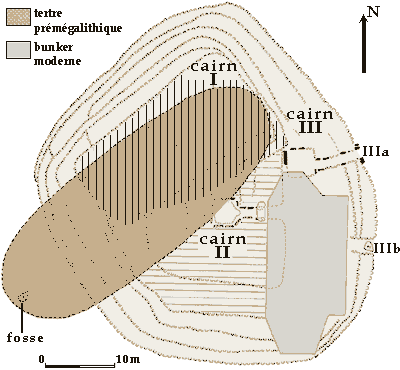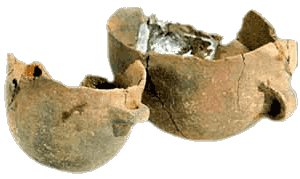- Home
- Megalithism in Morbihan
- Le Petit-Mont
- Before the megaliths
The Rhuys Peninsula, like the rest of the southern Armorican coast, reveals signs of lasting human settlements.
On the Petit-Mont headland for instance, an early Palaeolithic chopper was discovered near the cairn.
However, the oldest remains in the vicinity only date back to the middle Mesolithic with the traces of a camp on the nearby Kerjouanno headland, probably dating from the 7th millennium BC.
An early Neolithic settlement is testified not far from the monument. In the nearby Leen-Vihan quarry, two "Chambon type" ovoid drinking vessels were found with several sherds decorated with raised pushed through dots, a technique peculiar to the Cerny group, indicating that they date from the middle of the 5th millennium BC, at the latest.
The first monument may have been erected on the Petit-Mont headland at that early date. It is a low (1.6m high) oval mound (49m long and 15m maximum width). Because it was mostly buried under the cairns which followed (and protected it) this mound has only been partially explored.
Stones were placed in a half crown shape on the S/W end; a shallow pit with the remains of a stone block seeming to point to the location of a menhir which may have been displaced at some earlier date.
No other structure was found during the excavations carried out there. This mound seems to be made up of a humus-bearing argillaceous sandy soil, rich in carbonaceous microparticles and forming a homogeneous mass.
Only flint flakes and lamellas have been found in this soil. This material may have been obtained by scraping the surrounding arable land, which would explain the shallowness of the soil in this area. A radiocarbon dating points to the 4580-4460 BC range, but the carbon grains found in the soil may be due to an earlier burning.
Other structures, steles or menhirs for instance may also have already been erected in the surrounding area.
On the other hand, the palynologic analyses carried out during the latest excavations have revealed that the cairns were erected on cleared land that had already been a primitive agricultural area with some cereals and had been widely colonised by ruderal plants.
Plan of the mound
The two ovoid drinking vessels of Leenvihan.

